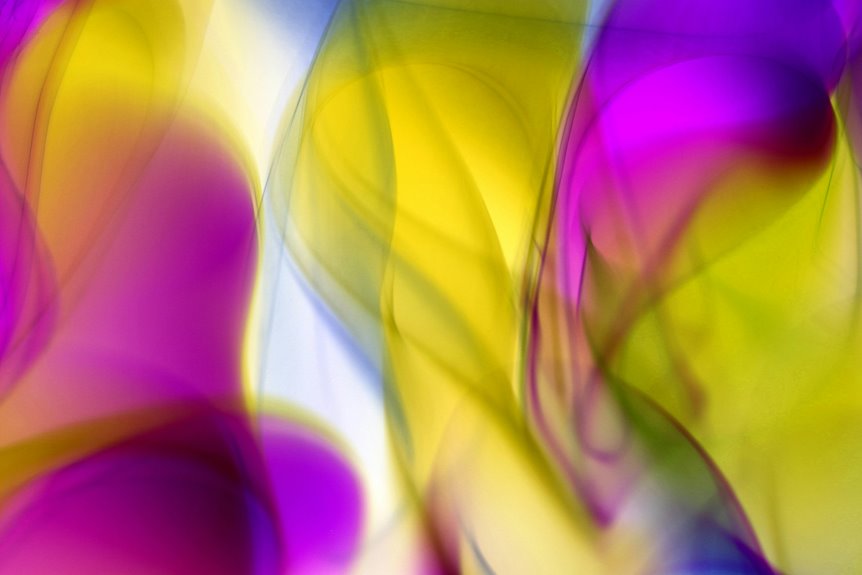To fix webcam color balance problems, start by adjusting your lighting conditions. Natural light works best, so position yourself near a window when possible. Next, calibrate your webcam settings—tweak brightness, contrast, and saturation for better results. Consider using software solutions for color correction like OBS Studio or Zoom filters. Finally, choose neutral backgrounds to avoid color casts. With these tips, you'll improve your video quality significantly, and there's more to explore on enhancing your setup.
Table of Contents
Key Takeaways
- Adjust lighting by using natural light or soft diffused sources to improve overall color balance in your webcam footage.
- Calibrate webcam settings by tweaking brightness, contrast, and saturation for more accurate color representation.
- Test your webcam in various lighting conditions and record short clips to identify color issues and make necessary adjustments.
- Use webcam software with color correction features, such as OBS Studio, to fine-tune color balance directly.
- Choose a neutral background with matte finishes to avoid color casts and enhance the overall clarity of your video.
Understanding Color Balance in Webcams
When you're using a webcam, understanding color balance is crucial for achieving a natural and appealing image.
Color balance refers to how the colors in your video appear, particularly the warmth or coolness of the tones. If your webcam's color balance is off, you might look too yellow, blue, or even green. This can happen due to various factors, including lighting conditions and camera settings.
To achieve the best results, aim for a balanced representation of skin tones and avoid extreme color casts. You can typically adjust these settings in your webcam software.
Experiment with different settings until you find the right balance that enhances your appearance while maintaining realism. A well-calibrated color balance makes a big difference in your video quality.
Adjusting Lighting Conditions
To improve your webcam's color balance, start by optimizing your lighting conditions.
Natural light can work wonders, but you might also want to explore artificial lighting options that reduce shadows.
Avoiding harsh shadows is key to achieving that perfect look on camera.
Natural Light Optimization
While natural light can enhance your webcam's image quality, it can also create color balance issues if not managed properly.
To optimize natural light, position yourself facing a window, allowing soft, diffused light to illuminate your face. Avoid harsh sunlight, which can wash out colors and create unflattering shadows. If the light is too bright, use sheer curtains to soften it.
You might also consider adjusting your webcam settings, like white balance, to better align with the lighting conditions. Experiment with different times of day to find the best natural light for your setup.
Artificial Lighting Options
If you want to enhance your webcam image further, incorporating artificial lighting can make a significant difference.
The right lighting not only brightens your space but also ensures accurate color representation. Here are some effective options to consider:
- Softbox lights: These provide diffused lighting, reducing harsh contrasts and creating a more flattering appearance.
- Ring lights: Known for their even illumination, they help eliminate shadows and highlight your features, making them a popular choice for streamers and content creators.
- LED panels: Versatile and adjustable, LED panels offer various color temperatures to match your environment, helping you achieve the desired look.
Experiment with these options to find the perfect lighting setup that enhances your webcam's color balance.
Avoiding Harsh Shadows
Harsh shadows can significantly detract from the quality of your webcam image, making it essential to adjust your lighting conditions effectively.
To avoid these unwanted shadows, position your light source in front of you, rather than above or to the side. Soft, diffused lighting works best, so consider using lamps with lampshades or LED panels with softboxes.
If you're using natural light, aim for a spot near a window during the day, but avoid direct sunlight. You might also want to use reflectors to bounce light back onto your face, reducing shadows.
Experiment with angles and distances until you find the setup that provides even lighting, enhancing your webcam image without harsh contrasts.
Calibrating Your Webcam Settings
Calibrating your webcam settings is essential for achieving optimal image quality. Start by accessing your webcam's settings through the software you're using. Adjust the brightness, contrast, and saturation to suit your environment and lighting conditions.
Here are some key adjustments to consider:
- Brightness: Ensure your image isn't too dark or washed out.
- Contrast: Balance the light and dark areas for a more defined image.
- Saturation: Fine-tune the color intensity to avoid overly vibrant or dull colors.
Take the time to experiment with these settings until you find the perfect balance.
Don't forget to check your image in different lighting situations to ensure consistency. Proper calibration can dramatically improve your video quality during calls and recordings.
Using Software Solutions for Color Correction
After you've fine-tuned your webcam settings, you might still notice some color imbalances in your video feed.
Fortunately, software solutions can help you achieve a more accurate color representation. Start by using webcam software that includes color correction features, such as OBS Studio or ManyCam. These programs allow you to adjust brightness, contrast, saturation, and hue directly.
You can also explore video conferencing tools like Zoom, which offer built-in filters to enhance your appearance. If you want more control, consider using photo editing software like Adobe Photoshop or Lightroom to adjust still images before using them in your video.
Experiment with different settings until you find the perfect balance for your unique lighting situation.
Exploring External Lighting Options
While adjusting your webcam settings can improve color balance, the right external lighting can make a significant difference in your video quality.
By incorporating proper lighting, you can enhance your appearance and ensure your colors look more accurate. Here are some options to consider:
- Softbox Lights: These provide diffused, even lighting and reduce harsh shadows.
- Ring Lights: Perfect for close-ups, they create a flattering light around your face, minimizing blemishes.
- Natural Light: Position yourself near a window during the day for bright, natural illumination that enhances color balance.
Experiment with these lighting options to find what works best for you.
With the right setup, your webcam video will look vibrant and professional.
Checking Background Colors and Materials
When setting up your webcam, the colors and materials in your background can significantly affect your video quality.
You should analyze your surrounding color scheme and consider how different lighting conditions interact with those colors.
Opting for neutral backgrounds can help ensure your webcam captures you in the best light possible.
Analyze Surrounding Color Scheme
How do the colors in your background affect your webcam's image quality? The hues around you can significantly impact how your camera perceives color balance. If your background is too vibrant or clashing, it can distort your appearance on screen.
You want to create a harmonious environment that complements your features rather than detracts from them.
Consider these aspects when analyzing your surrounding color scheme:
- Neutral tones: Opt for soft, muted colors to prevent overpowering your image.
- Complementary colors: Choose shades that enhance your skin tone and eye color.
- Reflective materials: Avoid shiny surfaces that can create unwanted glare or color casts.
Consider Lighting Conditions
Lighting can make or break your webcam's color balance, so it's crucial to assess your environment carefully.
Pay attention to the colors and materials in your background, as they can reflect light and affect how your camera captures colors. For instance, bright or overly saturated colors can create an unflattering hue, while dark materials may absorb light, resulting in dull images.
Natural light is usually your best friend, but if you're using artificial lighting, consider its color temperature. Avoid mixing different light sources, like fluorescent and incandescent, since they can clash and distort colors.
Use Neutral Backgrounds
To achieve the best color balance in your webcam feed, choosing a neutral background is essential. Bright or overly colorful backgrounds can distort your webcam's color settings, making your image appear off.
By opting for neutral tones, you help your camera focus on you instead of the distractions behind you.
Here are some tips to select the right background:
- Use solid colors: Soft grays, whites, or beiges work well.
- Avoid patterns: Busy designs can confuse the camera's sensors.
- Check materials: Matte finishes minimize reflections, which helps maintain color accuracy.
Testing and Fine-Tuning Your Setup
Testing your webcam setup is crucial for achieving the best color balance. Start by recording short video clips in different lighting conditions. Observe how colors appear and adjust settings as necessary. Use the table below to track your settings and results.
| Setting | Result |
|---|---|
| Natural Light | Warm tones, soft colors |
| Overhead Lighting | Harsh shadows, cool tones |
| Softbox Setup | Balanced colors |
| Fluorescent Lighting | Green tint |
| Sunset Lighting | Vibrant, warm hues |
After each test, tweak your camera's white balance and exposure. This fine-tuning process can make a significant difference, ensuring your videos look professional and true to life. Don't skip this vital step!
Frequently Asked Questions
What Are Common Causes of Webcam Color Balance Issues?
Webcam color balance issues often arise from poor lighting, incorrect camera settings, or outdated drivers. You might also notice discrepancies due to background colors or reflective surfaces affecting how your webcam captures and processes colors.
Do Different Webcams Have Varying Color Balance Capabilities?
Yes, different webcams have varying color balance capabilities. Some models offer advanced settings and adjustments, while others might struggle with accuracy. It's essential to choose one that meets your specific needs for optimal performance.
Can I Use Mobile Apps for Color Correction?
Yes, you can use mobile apps for color correction. These apps offer various filters and adjustments, allowing you to enhance your video's color balance effectively. Just download one and start improving your images right away!
How Does My Internet Connection Affect Webcam Color Quality?
Your internet connection impacts webcam color quality by affecting streaming stability. If you're experiencing lag or interruptions, the video may appear pixelated or distorted, which can alter the colors and overall image clarity during your calls.
Will Changing My Webcam Resolution Impact Color Balance?
Changing your webcam resolution can affect color balance. Higher resolutions may capture more detail, but they can also strain your camera's processing ability, potentially leading to color distortions. Experimenting might help you find the best settings.




